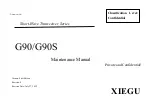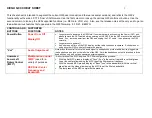
50
En
Speaker Configuration
With these settings, you can specify which speakers are
connected and a crossover frequency for each speaker.
Specify “
Full Band
” for speakers that can output low
frequency bass sounds adequately, for example, speakers
with a good sized woofer. For smaller speakers, specify a
crossover frequency. Sounds below the crossover
frequency will be output by the subwoofer instead of the
speaker. Refer to your speaker’s manuals to determine the
optimum crossover frequencies. If you set up your
speakers using Audyssey MultEQ XT32 Room Correction
and Speaker Setup, please make sure manually that any
THX speakers are set to “
80Hz(THX)
” crossover.
■
Subwoofer
`
1ch
:
The audio signal is outputted from
SW
/
SUBWOOFER 1
jack only.
`
2ch
:
The audio signal is outputted from
SW
/
SUBWOOFER 1
and
2
jacks.
`
No
Note
• If the “
Passive Subwoofer
” setting is set to “
Yes
”, “
No
” cannot
be selected here.
■
Front
`
Full Band
`
40Hz
,
45Hz
,
50Hz
,
55Hz
,
60Hz
,
70Hz
,
80Hz(THX)
,
90Hz
,
100Hz
,
110Hz
,
120Hz
,
130Hz
,
150Hz
,
200Hz
Note
• If the “
Subwoofer
” setting is set to “
No
”, the “
Front
” setting is
fixed to “
Full Band
”.
■
Center
*1
, Surround
*1*2
, Surround Back
*3*4*5*6
`
Full Band
`
40Hz
,
45Hz
,
50Hz
,
55Hz
,
60Hz
,
70Hz
,
80Hz(THX)
,
90Hz
,
100Hz
,
110Hz
,
120Hz
,
130Hz
,
150Hz
,
200Hz
`
None
■
Front Wide
*1*3*7*8
, Front High
*1*3*7*8
`
Full Band
`
40Hz
,
45Hz
,
50Hz
,
55Hz
,
60Hz
,
70Hz
,
80Hz(THX)
,
90Hz
,
100Hz
,
110Hz
,
120Hz
,
130Hz
,
150Hz
,
200Hz
`
None
Note
*1
“
Full Band
” can be selected only when “
Full Band
” is
selected in the “
Front
” setting.
*2
If the “
Powered Zone 4
” setting is set to “
Yes
”
(
➔
page 49
), this setting cannot be selected.
*3
If the “
Surround
” setting is set to “
None
”, this setting cannot
be selected.
*4
If the “
Surround
” setting is set to anything other than “
Full
Band
”, “
Full Band
” cannot be selected here.
*5
When the “
Powered Zone 3
” setting is set to “
Yes
”, this
setting cannot be used.
*6
When “
Front High + Front Wide
” is set to “
Yes
”, this
setting cannot be selected.
*7
If “
Bi-Amp
” is selected, or the “
Powered Zone 2
” setting is
set to “
Yes
”, this setting cannot be selected.
*8
If the “
Passive Subwoofer
” setting is set to “
Yes
”
(
➔
page 49
), this setting cannot be selected.
■
Surround Back Ch
`
1ch
:
Select if only one surround back speaker L is
connected.
`
2ch
:
Select if two (left and right) surround back speakers
are connected.
Note
• If the “
Surround Back
” setting is set to “
None
”, this setting
cannot be selected.
■
LPF of LFE
(Low-Pass Filter for the LFE Channel)
`
80Hz
,
90Hz
,
100Hz
,
110Hz
,
120Hz
`
Bypass
:
Low-Pass Filter is not applied.
With this setting, you can specify the cutoff frequency
of the LFE channel’s low-pass filter (LPF), which can
be used to filter out unwanted hum. The LPF only
applies to sources that use the LFE channel.
Note
• If you’re using THX-certified speakers, select “
80Hz
”.
■
Double Bass
`
On
`
Off(THX)
Turn this setting on to boost bass output by feeding bass
sounds from the front left, right, and center channels to the
subwoofer.
Note
• This function can be set only if the “
Subwoofer
” setting is set to
“
1ch
” or “
2ch
”, and the “
Front
” setting is set to “
Full Band
”.
• If you’re using THX-certified speakers, select “
Off(THX)
”.
This setting is set automatically by
Audyssey MultEQ
®
XT32 Room Correction and
Speaker Setup function (
➔
page 31
).
This setting is
NOT
set automatically by
Audyssey MultEQ XT32 Room Correction and Speaker
Setup function (
➔
page 31
).
Summary of Contents for DTR-70.3
Page 1: ...AV Receiver DTR 80 3 DTR 70 3 Instruction Manual...
Page 106: ...106 En Memo...
Page 107: ...107 En Memo...
















































